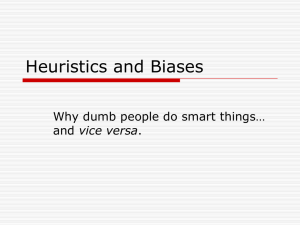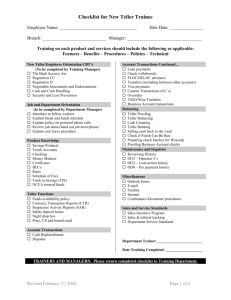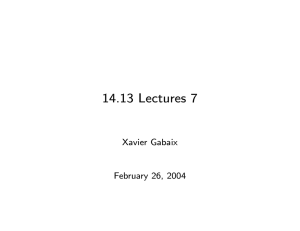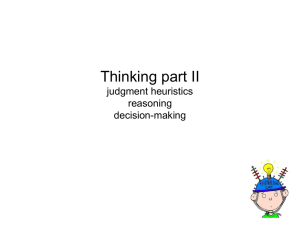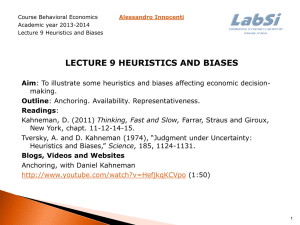Heuristics and Biases
advertisement
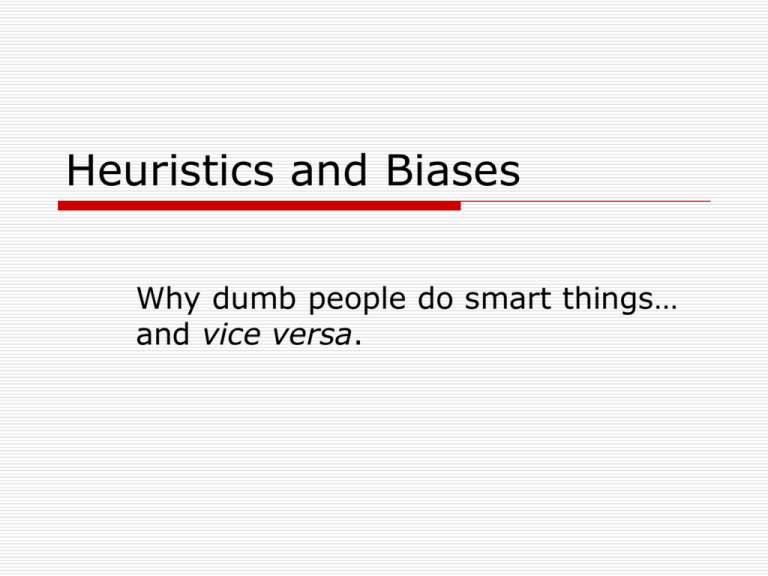
Heuristics and Biases Why dumb people do smart things… and vice versa. Overview Context Heuristics as biases (defects) Availability Anchoring and adjustment Representativeness (Revisited) Heuristics as intelligence Recognition “Fast and frugal” Tit-for-tat (social heuristics Conclusion Context Rational Choice Theory Utility Theory Probability Theory Bounded Rationality Rational Choice Theory von Neumann & Morgenstern (1947) attempted to remove psychological assumptions from the theory of decision making: Individuals have precise information about the consequences of their actions Individuals have sufficient time and capability to weigh alternatives All decisions are “forward looking” (e.g., the “sunkcost fallacy”) “Game theory” is RCT in practice Utility & Probability Theory UT determines how preferences are determined within RCT A response to the St. Petersburg Paradox (1734) Strictly construed, UT assigns a common currency (utiles) to disparate outcomes Probabilistic reasoning Under uncertainty, the “value” of a choice is the expected value of probabilistic outcomes Savage (1972) formalized the conjunction of UT and Bayesian probabilistic reasoning Bounded Rationality Acknowledges several limitations of UT and RCT as descriptive models of individual choice People lack: Perfect information of outcomes and probabilities Consistent utility functions across domains Time and cognitive capabilities to comprehensively enact the prescriptions of UT and RCT Experts and everyday decision makers are errorprone Useful in the domain of problem-solving Simon (1955) argued for satisficing Individuals make decisions that are “good enough” considering the costs of decision-making, the specific goal, and cognitive limitations Why heuristics? RCT & UT are terrible descriptive models in many cases Bounded Rationality’s limitations are insufficient to explain human behavior Sometimes information is insufficient even for BR Many judgments are not goal-directed or encased in problem-solving tasks Human errors are systematic Discovering heuristic rules of judgment can explain these systematic errors Heuristics Substitute easy questions for difficult ones (attribute substitution) Defined heuristic rules specify the substitution Allow judgment and decision making in cases where specific and accurate solutions are either unknown or unknowable Availability, anchoring and adjustment, and representativeness are frequently considered “metaheuristics” since they engender many specific effects Heuristics as error-generators How smart people do dumb things Kahneman, Slovic, & Tversky (1974) Availability Anchoring and adjustment Representativeness Availability Heuristic “The ease with which instances or occurrences can be brought to mind” motivates judgment Retrievability of instances “Were there more males or females on a given list?” Effectiveness of a search set “Do more English words begin with r or have r as the third letter?” Biases of imaginability in ad hoc categories “Which is larger: 10 C 2 or 10 C 8?” Illusory correlation Chapman & Chapman (1969) Condition 1 1×2×3×4×5×6×7×8 = ? Condition 2 8×7×6×5×4×3×2×1 = ? Anchoring and adjustment Insufficient adjustment Condition 1: 1×2×3×4×5×6×7×8 Mean answer: 512 Condition 2: 8×7×6×5×4×3×2×1 Mean answer: 2250 Anchoring and adjustment Correct answer: 8! = 1×2×3×4×5×6×7×8 = 8×7×6×5×4×3×2×1 = 40,320 Anchoring and adjustment Biases in the evaluation of conjunctive and disjunctive events Probability of conjunctive events overestimated Probability of disjunctive evens underestimated Anchoring in the assessment of subjective probability distributions Variance of estimated probability distributions narrower than actual probability distributions Common to naïve and expert respondents Representativeness Likelihood of a condition is judged by similarity to a condition, mitigating factors notwithstanding Insensitivity to prior probability of outcomes “Imagine a group of (70/30) lawyers and (30/70) engineers.” “Dick is a 30 year old man. He is married with no children. A man of high ability and high motivation, he promises to be quite successful in his field. He is wellliked by his colleagues.” Participants judged Dick to be equally likely to be an engineer regardless of prior probability condition Base rate neglect Representativeness Insensitivity to sample size A certain town is served by two hospitals. In the larger hospital about 45 babies are born each day, and in the smaller hospital about 15 babies are born each day. As you know, about 50 percent of all babies are boys. However, the exact percentage varies from day to day… For a period of 1 year, each hospital recorded the days on which more than 60 percent of the babies born were boys. Which hospital do you think recorded more such days? The larger hospital (21) The smaller hospital (21) About the same (within 5% of each other) (53) Representativeness Misconceptions of chance “The law of large numbers applies to small numbers as well.” Expert researchers select sample sizes too small to fairly test hypotheses (Cohen, 1969) Conjunctive fallacy Linda! Robust effect: Linda is more likely to be a bank teller than she is to be a feminist bank teller, because every feminist bank teller is a bank teller, but some women bank tellers are not feminists, and Linda could be one of them Representativeness Conjunctive fallacy Linda! Robust effect: 1. Linda is more likely to be a bank teller than she is to be a feminist bank teller, because every feminist bank teller is a bank teller, but some women bank tellers are not feminists, and Linda could be one of them 2. Linda is more likely to be a feminist bank teller than she is likely to be a bank teller, because she resembles an active feminist more than she resembles a bank teller 65% of participants selected argument 2 Representativeness Misconceptions of Regression to the Mean Why flight instructors conclude that criticism is more effective than praise Heuristics as intelligence How dumb people do smart things: when less (information) is more Recognition Heuristic Who will win in the soccer match: Manchester United vs. Shrewsbury Town? (Ayton & Onkal, 1997) Which has a greater population: San Diego or San Antonio? (Goldstein & Girgerenzer, 2002) Turkish participants as accurate as British in the former; German participants more accurate than American in the latter “Fast and Frugal” Heart-attack patient Standard, multivariate patient-interview vs. Limited-information decision tree of 3 yes/no Q’s. Decision tree “more accurate in classifying risk than complex statistical methods” (Breiman et al., 1993) , in (Todd and Gigerenzer, 1999) “Tit-for-tat” Simple game-theory strategy: In the first round: always cooperate Subsequently: Remembers partner’s (opponent’s) one (!) previous response Reciprocates previous response This simple cooperation heuristic bested many highly sophisticated algorithms that based their decisions on high memory of partner’s actions and intense computational machinery (Axelrod, 1984) Interacts well with other tit-for-tat machines as well “Why selfish people do nice things” – a simple heuristic for social cooperation Heuristics: bias or intelligence Bias View limited decision-making methods that people often misapply to situations where UT, RCT, and PT should be applied instead instantaneous responses based on attribute substitution – switch hard questions for easy ones sources of predictable error and underperformance Intelligence View “intelligent behavior” need not be computationally expensive frugal representations and response mechanisms are more tractable and plausible simple rules can generate rich cognitive and social effects
